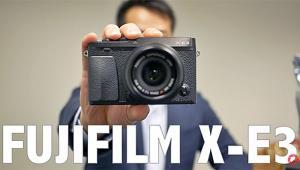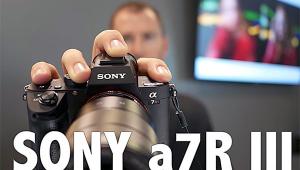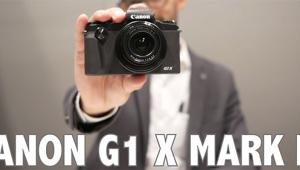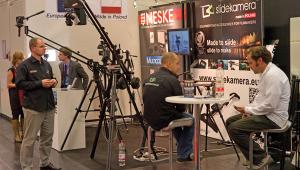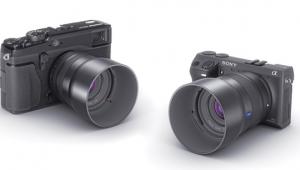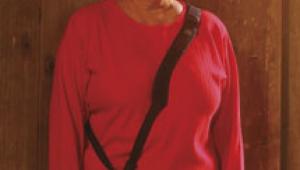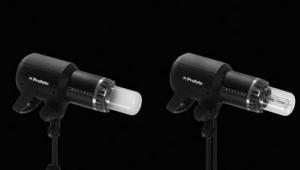Some Niches, At Best Page 2
 |
 |
||
|
|
35mm Rangefinder
That was it for medium and large format, so it is time to move on to 35mm rangefinder
cameras, which were also part of my brief. Here, the big news was a new lens
from Leica, a 75mm f/2 Summicron. They didn't even have a prototype for
me to play with but by the time you read this it will at least have been officially
announced--it was under embargo at PMA--even if it is not actually
available. Look for a road test as soon as I can get one! Also from Leica, again
under embargo for introduction later in the year, was a right-angle finder to
screw into the eyepiece of the M: particularly useful with the Macro-Elmarit-M
and close-up adapter when you are using a copy stand for repro sizes down to
1/3 life size.
 |
|
|
The Zeiss Ikon was still not available--in fact it still wasn't
finalized, with details such as the layout of the information available in the
viewfinder subject to change--but I'm hoping to see a review outfit
before you read these words. The Japanese-built lenses (21-25-28-35-50mm) were
available and selling well but the German-built lenses (15 and 85mm) were slated
to appear at the same time as the body in May. On the same stand--Hasselblad--there
was no news except that the Xpan II was selling well.
Nothing new on the Voigtländer front, though the 18mm should now be available
and I now have an R3A for test, and as for Rollei, the only real news (still
very welcome) was that prices have fallen somewhat: you should be able to buy
a body plus standard lens for around $1000 US, which given the lamentable weakness
of the dollar is very impressive indeed.
 |
|
|
Studio Lighting
At least four factors have contributed to a resurgence of continuous lighting
(as opposed to flash). One is fashion: since I started in advertising photography
30-odd years ago I have seen the pendulum swing back and forth between continuous
lighting and flash. Second, there is the growth of the Internet, with its voracious
appetite for illustrations, preferably (though far from invariably) at least
competently lit and exposed: this has led to a significant increase in the demand
for studio lighting. Third, many amateurs are frightened of flash: they see
it as complicated and expensive, and they are not always wrong. Fourth, there
are new technologies which allow "hot" lights to run a lot cooler
than even the modeling lights on flash units: the two most noteworthy are high-frequency
fluorescents with astonishingly good spectral matches to daylight and metal-halide
lamps, a sort of poor man's HMI that allows (for example) the same light
from 150w as would take 600w of tungsten lighting.
 |
|||
|
|||
 |
 |
||
|
|
||
There are quite a few of both on the market. The four new ones that particularly caught my eye, in the order in which I saw them, were Westcott's "Spider" with five curly fluorescent lamps that can be switched to use one, two, three, or five of the lamps; Paterson's straight-tube light bank with mirrored barn doors; Dot Line's metal-halide heads from their RPS Studio line; and some Omega lights that were so new that there was not even any information at the stand. APV also had some nice kits. It would be perfectly feasible to put together a two- or three-head continuous lighting kit for under $1000, while still keeping power consumption below fuse-blowing levels and without the baking heat that big tungsten lights give off.
PMA Blues
Overall, as I hinted at the beginning, I never find the PMA Show as interesting
as photokina. This is not just the size: obviously, there is going to be more
interesting stuff at a worldwide fair that is five or 10 times the size of a
regional show. Rather more to the point, the little companies who often did
so much to make the PMA Shows so interesting a decade and more ago have been
squeezed out by the sheer cost of exhibiting. Quite a number of exhibitors confided
that they were only at PMA because if they weren't, people would wonder
if they were having financial problems or had even gone bust. I also heard three
good rumors--all photo shows are a hotbed of rumors--that at least
one of the very biggest exhibitors was questioning the value of being at PMA
instead of electronics trade shows such as CES or open-to-the-public shows such
as the New York show. If they went, others would follow and PMA might well dry
up and blow away. All right, this year's PMA was handicapped by a number
of factors including overlaps with both a public holiday (Presidents'
Day) and Daytona Race Week, and Orlando is never as popular as Las Vegas or
New Orleans: some call it Borelando. But even without the handicaps, it wasn't
much of a show for the traditional photo enthusiast.
Manufacturers/Distributors'
addresses can be found on page 176.
- Log in or register to post comments
